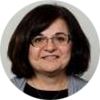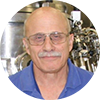Cambridge Healthtech Institute’s 10th Annual
Optimizing Cell Line Development
Enhancing Expression
August 16-17, 2018
Cell Line Development has reached a new plateau influenced by genomic research and insights, along with emerging technologies that are pushing cell engineering into an uncharted future. The “Optimizing Cell Line Development” conference brings
together cell line development experts who are forging this new era. They will share how to best optimize codons, construct vectors, and how to select and engineer clones and host systems, while maintaining stability and consistency. The conference
will also focus on genomic research for CHO and other systems, as well as glycoengineering, systems biology, assays, and pathway delineation. In addition, challenges for introducing new technologies will be discussed, along with an overview of industrial
trends and regulatory perspectives.
Thursday, August 16
11:30 am Registration Open (Grand Ballroom Foyer)
12:15 pm Enjoy Lunch on Your Own
1:15 10th Anniversary Cake Break in the Exhibit Hall with Last Chance for Poster Viewing (Grand Ballroom)
1:55 Chairperson’s Remarks
Claus Kristensen, PhD, CEO, GlycoDisplay Aps
2:00 KEYNOTE PRESENTATION:
Product Quality Control Strategies during Cell Line Development
 Zhimei Du, PhD, Director, Cell Line Development, Biologics Process Development & Clinical Manufacturing, Merck Research
Labs
Zhimei Du, PhD, Director, Cell Line Development, Biologics Process Development & Clinical Manufacturing, Merck Research
Labs
Product quality control without compromising productivity has been a major goal in biotherapeutics process development. The challenge is further increased for new modalities using complex and hybrid protein structures. To improve the efficiency in
developing a successful production cell line with desired product quality profile, implementation of various near real-time monitoring system at different stage of cell line development would be critical and will be illustrated in this presentation.
2:45 Cell Line Development for Expression of Bispecific and Trispecific Molecules
 Valentina C. Ciccarone, PhD, Principal Scientist, Cell Line Development, Macrogenics, Inc.
Valentina C. Ciccarone, PhD, Principal Scientist, Cell Line Development, Macrogenics, Inc.
Bispecific DART® and trispecific TRIDENT™ molecules have been designed to achieve multiple mechanisms of action and clinical applications. They are composed of two to four peptide chains which need to assemble correctly for functional activity. The appropriate expression of each component by the production cell line is important in achieving high expression levels and product quality in order to successfully manufacture the clinical product. By incorporating molecule engineering strategies, optimizing vector selection, and cell line screening, we have been able to achieve correct molecule assembly, high expression levels, and biological activity of these complex, multi-chain molecules.
3:15 Improved Recombinant Protein Expression from Mammalian Cells by Manipulating Genes Identified through miRNA and siRNA Screening
 Joseph Shiloach, PhD, Director, Biotechnology Core Laboratory, Intramural Research, NIDDK/NIH
Joseph Shiloach, PhD, Director, Biotechnology Core Laboratory, Intramural Research, NIDDK/NIH
From a whole-genome RNA interference screen of HEK 293 cells, 10 genes were identified and validated by their effect on protein expression. From these genes, OAZ1 was selected for further investigation because its silencing improved protein
production without affecting cell viability and because its role in polyamine metabolism is known. Another protein enhancing gene, HIPK1, was identified by utilizing both miRNA and siRNA screening. The gene identification process and the
creation, the growth, and production properties of the engineered cells will be described.
3:45 A Novel Approach to Cell Line Selection Using RNA
 Ted Eveleth, CEO, HocusLocus, Inc.
Ted Eveleth, CEO, HocusLocus, Inc.
Our novel approach to cell line selection replaces marker proteins, like DHFR and GS, with an siRNA contained within an intron in the gene of interest transcript. Subsequent selection can be performed by transfecting mRNA and then using
either FACS or magnetic-based isolation to produce a pool.
4:00 Refreshment Break (Foyer)
4:15 Programmed Gene Regulatory Networks for Cell Line Engineering
 Ron Weiss, PhD, Professor, Biological Engineering, Massachusetts Institute of Technology (MIT)
Ron Weiss, PhD, Professor, Biological Engineering, Massachusetts Institute of Technology (MIT)
Synthetic biology is revolutionizing how we conceptualize and approach the engineering of biological systems. Recent advances in the field are allowing us to expand beyond the construction and analysis of small gene networks towards the
implementation of complex multicellular systems with a variety of applications. In this talk, I will describe our integrated computational/experimental approach to engineering complex behavior in a variety of cells, with a focus on
mammalian cells.
4:45 Utilizing RNA Epigenetic Modifications to Enhance Transgene Expression
 Niall Barron, PhD, Professor, Biochemical Engineering, National Institute for Bioprocessing Research
and Training (NIBRT), University College Dublin
Niall Barron, PhD, Professor, Biochemical Engineering, National Institute for Bioprocessing Research
and Training (NIBRT), University College Dublin
One modified base that has generated considerable interest recently is N6-methyladenosine (m6A), which is one of the most common epigenetic modifications found on RNA. While much effort has been dedicated to elucidating the role of m6A,
there remains a lot of questions around its true biological role. Our interest has focused on its potential as an enhancer of mRNA translation and how this mechanism might be applied to improving recombinant protein expression systems.
5:15 End of Day
6:00 - 9:00 Recommended Dinner Short Course*
SC13C: Implementing Phase Appropriate GMP for Manufacturing Biologics and Cell Therapy Products
Instructor: Trevor Deeks, PhD, QA/QC and GMP Consultant, Deeks Pharmaceutical Consulting Services, LLC
* Separate registration required.
Friday, August 17
8:00 am Registration Open and Morning Coffee
8:25 Chairperson’s Remarks
Niall Barron, PhD, Professor, Biochemical Engineering, National Institute for Bioprocessing Research and Training (NIBRT), University College Dublin
8:30 FEATURED PRESENTATION:
Robust and Flexible Approaches towards High Quality Cell Lines
 Volker Sandig, PhD, CSO, Probiogen AG
Volker Sandig, PhD, CSO, Probiogen AG
In this talk, we will discuss how the CHO starter cell, vector, culture media and even selection principles can drive performance of a cell line development platform and show implications for glycoproteins as well as bispecific
antibodies. We will also address challenges to verify single cell origin of the final cell line and describe a novel approach for gentle cloning with embedded validation co-developed with Automated Lab Systems (ALS).
9:00 Optimization of a Stable CHO-K1-Based Cell Line for FAP-DR5 2+2 CrossMab Antibody in Order to Increase Product Quality and Yield
 Stefan Seeber PhD, Principal Scientist, Molecule & Cell Line Development, Roche Innovation
Center Penzberg
Stefan Seeber PhD, Principal Scientist, Molecule & Cell Line Development, Roche Innovation
Center Penzberg
We have generated a recombinant, stable CHO-K1-based cell line for a novel tetravalent FAP-DR5 (2+2 type CrossMab) antibody, which effectively triggers FAP-dependent, avidity-driven DR5 hyperclustering and tumor cell apoptosis.
The application of our cell line development platform comprising semi-automation and a diligent cell line selection strategy resulted in final cell clones, which showed a stable product profile and high yield, but side
peaks which referred to limitations in crossed light chain expression. In the talk, we describe the strategy and execution of targeted cell line optimization leading to a final cell line with improved quality and yield.
9:30 Evaluating CRISPR-Cpf1 as a Genome Editing Technology in Chinese Hamster Ovary (CHO) Cells
 Zhuo Cheng, PhD, Research Scientist, Molecular and Cell Biology, Bioprocess R&D, Eli Lilly
and Company
Zhuo Cheng, PhD, Research Scientist, Molecular and Cell Biology, Bioprocess R&D, Eli Lilly
and Company
Cpf1 has been reported to be highly specific and efficient in gene editing, at levels approaching that of the high fidelity Cas9 in human cells. This study demonstrates that CRISPR/Cpf1 offers a viable alternative to the
commonly-leveraged CHO cell gene-editing tool ZFN. In a study, Cpf1 produced significantly more biallelic genetic knockouts than ZFN. Use of CRISPR/Cpf1 was successfully integrated into the cell line generation process
with no negative impacts on timeline, screen size or production cell line productivity.
10:00 Networking Coffee Break (Foyer)
10:30 Unlocking the Mysteries of CHO Cells Using Transcriptomic Analysis
 Philip Probert, PhD, Senior Upstream Scientist, Biologics, The Centre for Process
Innovation (CPI)
Philip Probert, PhD, Senior Upstream Scientist, Biologics, The Centre for Process
Innovation (CPI)
RNA Seq analysis using the Ion Torrent S5 instrument was used to characterise the gene expression profile of a number of CHO cell variants edited using CRISPR/Cas9 and grown under industrially relevant conditions using
an ambr 250 bioreactor system. Our results demonstrate that RNA Seq analysis provides an insight into the intracellular dynamics of mammalian cells during bioprocessing and could provide opportunities for cell engineering
by identifying potential gene targets to improve performance.
11:00 Optimization of Expression Vector Construction for Clinical Cell Line Development
 Yizhou Zhou, PhD, Scientist II, Cell Culture Development, Biogen
Yizhou Zhou, PhD, Scientist II, Cell Culture Development, Biogen
Optimal protein expression in stable CHO cells often requires optimization of the expression vectors. To streamline the transition from Research to Development, we have evaluated effects of different codon editing strategies
and signal peptide choices on stable cell line development. In addition, cloning strategies were also optimized to speed up the vector construction process.
11:30 Platform Automation and High Throughput Screening to Improve Monoclonal Antibody Production in CHO Cells
Daniel Kordella, MSc, Associate Scientist, Cell Line Development, NIH/NIAID
Our group has been working towards incorporation of two large/high throughput technologies in our cell line development process. The first is a large-scale liquid handler capable of automated expansion of cell lines at
every stage. The second is incorporation of a HTP screening platform capable of using multiple criteria to identify candidate cell lines and mark them for expansion. The two platforms are integrated in such a way that
data from screening is used to rapidly mark cell lines for expansion, which is then carried out automatically by the liquid handling platform.
12:00 Enjoy Lunch on Your Own
1:25 Chairperson’s Remarks
Zhuo Cheng, PhD, Research Scientist, Molecular and Cell Biology, Bioprocess R&D, Eli Lilly and Company
1:30 Automate Research Cell Line Generation with I-Cell Technology
 Leyu Wang, PhD, Senior Scientist II and Project Leader, Global Protein Sciences – Biologics,
AbbVie Bioresearch Center
Leyu Wang, PhD, Senior Scientist II and Project Leader, Global Protein Sciences – Biologics,
AbbVie Bioresearch Center
Engineering cell lines with surface antigen expression is essential for the discovery of new biologics targeting receptors. We developed an automated system iCell (Isolated Cell Culture) with the use of CellRaft arrays
for culturing thousands of single cells in a small footprint to speed up single cell cloning and generate high quality cell lines with minimal manual intervention. Proof-of-concept studies and efforts to automate the
ICell technology will be presented.
2:00 Optimizing Biologics by Cell-Based Glycoengineering
 Claus Kristensen, PhD, CEO, GlycoDisplay Aps
Claus Kristensen, PhD, CEO, GlycoDisplay Aps
Dr. Kristensen will discuss his group’s cell-based glycoengineering platform that displays different glycan structures on biologic candidates for optimization. Many protein researchers do not know which glycoform
is optimal for a particular protein, therefore, Dr. Kristensen’s group develops a series of glycovariants of a protein for screening in established assays. The presentation will introduce their cell-based platform
and how they apply their technology to optimize antibodies and other proteins.
2:30 Leaping-in to Cell Line Development: An Evaluation of ATUM’s Leap-in Transposase System
 Neal Schilling, PhD, Senior Scientist, Process Sciences, CHO Cell Line Development,
AbbVie Bioresearch Center
Neal Schilling, PhD, Senior Scientist, Process Sciences, CHO Cell Line Development,
AbbVie Bioresearch Center
Dr. Schilling will show data from an in-house evaluation of ATUM’s Leap-In® Transposase system. A cell line development campaign for a model mAb, from bulk pool generation through cloning and stability, will be presented.
3:00 Higher Throughput Cell Line Development Using the VIPS
 Thomas Kelly, Scientist, Cell & Developability Sciences, Janssen R&D
Thomas Kelly, Scientist, Cell & Developability Sciences, Janssen R&D
Standard limiting dilution cloning for CLD typically requires seeding densities of 0.5 cells/well in many 96-well plates to obtain enough clones for further evaluation. This results in mostly empty wells being plated, imaged,
and eventually consolidated. Solentim’s Verified in situ Plate Seeding (VIPS) system was recently released to the marketplace. It allows for automated seeding of cells at a target
of 1 cell/well with imaging. This allows for fewer 96-well plates seeded to screen the same amount of clones. This saves time in plating, imaging, consolidating clones, and titering.
3:30 Close of Conference